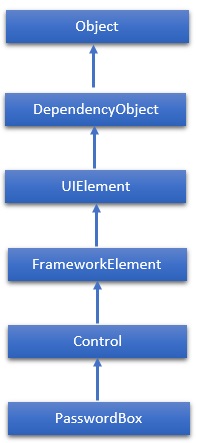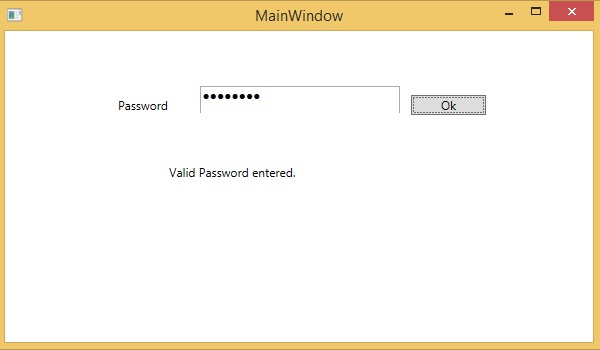
- XAML - Home
- XAML - Overview
- XAML - Environment Setup
- Writing XAML Aplication On MAC OS
- XAML Vs C# Code
- XAML Vs.VB.NET
- XAML - Building Blocks
- XAML - Controls
- XAML - Layouts
- XAML - Event Handling
- XAML - Data Binding
- XAML - Markup Extensions
- XAML - Dependency Properties
- XAML - Resources
- XAML - Templates
- XAML - Styles
- XAML - Triggers
- XAML - Debugging
- XAML - Custom Controls
XAML - PasswordBox
A PasswordBox is a control in which the user can enter a masked password. When the user enters a password, the text is not displayed, only the password characters are shown. The password character (usually shown as *) can be easily changed by the PasswordChar property. The hierarchical inheritance of PasswordBox class is as follows −

Properties
| Sr.No. | Property & Description |
|---|---|
| 1 |
InputScope Gets or sets the context for input used by this PasswordBox. |
| 2 |
InputScopeProperty Identifies the InputScope dependency property. |
| 3 |
IsPasswordRevealButtonEnabled Gets or sets a value that specifies whether the visual UI of the PasswordBox includes a button element that toggles showing or hiding the typed characters. In Windows 10 and later, use PasswordRevealMode instead. |
| 4 |
IsPasswordRevealButtonEnabledProperty Identifies the IsPasswordRevealButtonEnabled dependency property. |
| 5 |
MaxLength Gets or sets the maximum length for passwords to be handled by this PasswordBox. |
| 6 |
MaxLengthProperty Identifies the MaxLength dependency property. |
| 7 |
Password Gets or sets the password currently held by the PasswordBox. |
| 8 |
PasswordChar Gets or sets the masking character for the PasswordBox. |
| 9 |
PasswordCharProperty Identifies the PasswordChar dependency property. |
| 10 |
PasswordProperty Identifies the Password dependency property. |
| 11 |
PasswordRevealMode Gets or sets a value that specifies whether the password is always, never, or optionally obscured. |
| 12 |
PasswordRevealModeProperty Identifies the PasswordRevealMode dependency property. |
| 13 |
Resources Gets the locally defined resource dictionary. In XAML, you can establish resource items as child object elements of a frameworkElement.Resources property element, through XAML implicit collection syntax. (Inherited from FrameworkElement) |
Events
| Sr.No. | Event & Description |
|---|---|
| 1 |
ContextMenuOpening Occurs when the system processes an interaction that displays a context menu. |
| 2 |
GotFocus Occurs when a UIElement receives focus. (Inherited from UIElement) |
| 3 |
PasswordChanged Occurs when the value of the Password property changes. |
| 4 |
Paste Occurs when text is pasted into the control. |
Methods
| Sr.No. | Method & Description |
|---|---|
| 1 |
OnLostFocus Called before the LostFocus event occurs. (Inherited from Control) |
| 2 |
SelectAll Selects all the characters in the PasswordBox. |
| 3 |
SetBinding Attaches a binding to a FrameworkElement, using the provided binding object. (Inherited from FrameworkElement) |
| 4 |
SetValue Sets the local value of a dependency property on a DependencyObject. (Inherited from DependencyObject) |
Example
The following example shows the PasswordBox, labels, and a button. Here is the XAML code to create and initialize all these controls.
<Window x:Class = "PasswordBox.MainWindow"
xmlns = "http://schemas.microsoft.com/winfx/2006/xaml/presentation"
xmlns:x = "http://schemas.microsoft.com/winfx/2006/xaml"
Title = "MainWindow" Height = "350" Width = "604">
<Grid>
<PasswordBox x:Name = "pwBox"
Height = "35"
Width = "200"
MaxLength = "8"
Margin = "159,55,158,229" />
<Label Content = "Password"
HorizontalAlignment = "Left"
Margin = "108,61,0,0"
VerticalAlignment = "Top"
Width = "70" />
<Button Content = "Ok" HorizontalAlignment = "Left"
Margin = "406,64,0,0"
VerticalAlignment = "Top"
Width = "75" Click = "Button_Click"/>
<Label Name = "statusText"
HorizontalAlignment = "Left"
Margin = "159,128,0,0"
VerticalAlignment = "Top"
Width = "200"
Height = "38"/>
</Grid>
</Window>
Here is the button click event implementation in C# in which the program compares the password. If the entered password is xaml1234, then it will display the message "correct password" on the label.
using System.Linq;
using System.Windows;
using System.Windows.Controls;
namespace XAMLMenu {
public partial class MainWindow : Window {
public MainWindow() {
InitializeComponent();
}
private void MenuItem_Click(object sender, RoutedEventArgs e) {
MenuItem item = sender as MenuItem;
this.Title = "File: " + item.Header;
}
private void MenuItem_Click1(object sender, RoutedEventArgs e) {
MenuItem item = sender as MenuItem;
this.Title = "Edit: " + item.Header;
}
}
}
When you compile and execute the above code, it will produce the following output −

We recommend you to execute the above example code and experiment with some other properties and events.